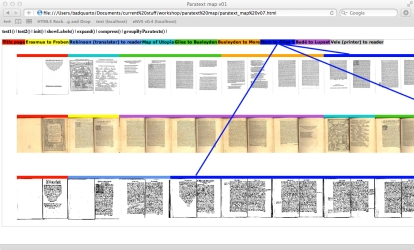Visualizing
Variation
Alan Galey
Faculty of Information
University of Toronto
individual.utoronto.ca/
alangaley
Paratext maps
(in progress)
 Paratexts are the features that define the social landscape in which a book was published and read. The term paratexts refers to a book's supplementary texts, including prefaces, dedications, epistles to readers, portraits, colophons, and other elements that accompany an author's text into the world. One might imagine paratexts as satellites orbiting the author's work; a more apt metaphor, however, might be paratexts as the succession of antechambers through which one enters the edifice of the author's text, a kind of architecture of the book that simultaneously invites and defers the reader's entry. Early modern books often have especially complex configurations of paratexts. These paratexts are valuable to researchers because they help us understand the social, political, economic, and aesthetic networks (sometimes multiple intersecting ones) that contextualized any given book, both for the book's producers and for its readers. However, those configurations of paratexts usually changed from edition to edition, and those patterns of change are difficult if not impossible to represent accurately in modern editions.
Paratexts are the features that define the social landscape in which a book was published and read. The term paratexts refers to a book's supplementary texts, including prefaces, dedications, epistles to readers, portraits, colophons, and other elements that accompany an author's text into the world. One might imagine paratexts as satellites orbiting the author's work; a more apt metaphor, however, might be paratexts as the succession of antechambers through which one enters the edifice of the author's text, a kind of architecture of the book that simultaneously invites and defers the reader's entry. Early modern books often have especially complex configurations of paratexts. These paratexts are valuable to researchers because they help us understand the social, political, economic, and aesthetic networks (sometimes multiple intersecting ones) that contextualized any given book, both for the book's producers and for its readers. However, those configurations of paratexts usually changed from edition to edition, and those patterns of change are difficult if not impossible to represent accurately in modern editions.
This visualization prototype allows digital editors to create interactive maps of the paratexts in a given book, as well as their relationship to paratexts appearing in other editions. Unlike topographical maps, however, this interface visualizes patterns in both space and time: the spatial sequence of paratexts in specific books, and the temporal sequence of paratextual variation over time in different editions. Together, these elements can provide a map of the bibliographical elements that shape a book's reception over time, and even in different publishing houses, countries, and translations. This prototype is my first experiment in image-based computing, and takes advantage of the animation and vector graphics capabilities of CSS3 and HTML5.